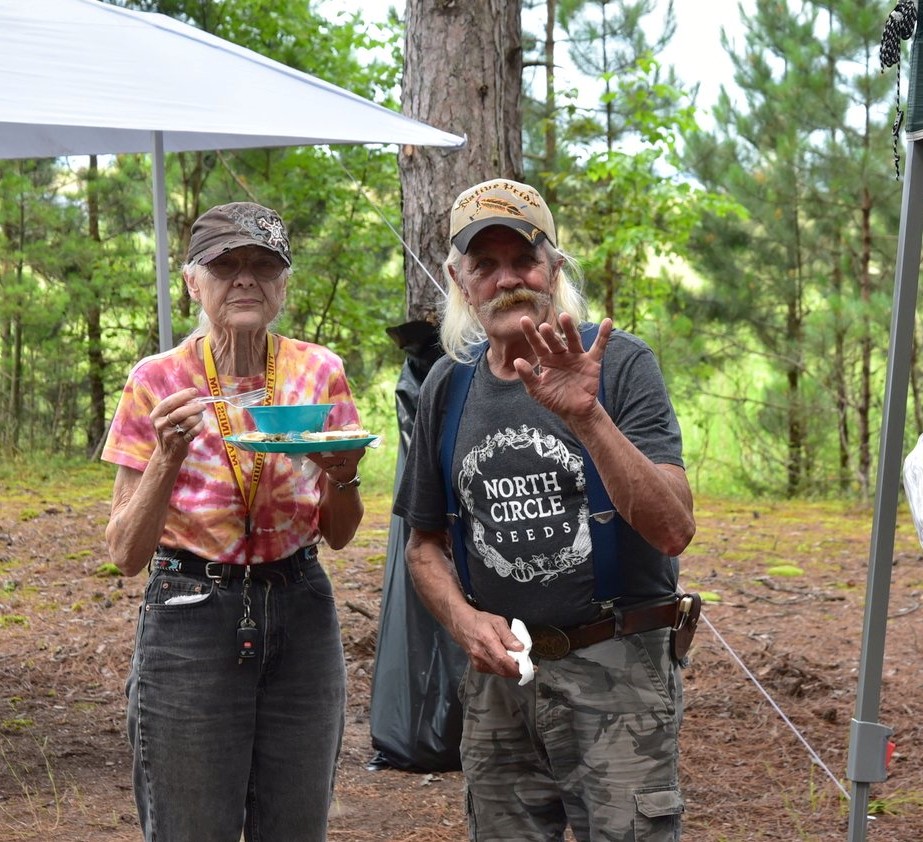
Christine Carlson and Mark McConnell. Image credit: Anna Martineau Merrit
Two speakers shared their wealth of knowledge with a large audience for the March River Talk, held at the Lake Superior Estuarium in Superior. The evening began with Christine Carlson, a historian and columnist for the Fond du Lac Tribe’s newspaper.
The talk was held on March 8, which was International Women’s Day. In honor of this, Carlson highlighted Sophie Bruin, a woman who lived on an island in the St. Louis River between Gary and New Duluth in a one-room cabin with her eight children. Her granddaughter Bea Bruin was in the audience. Newspaper accounts detailed their rescue by rowboat in 1897 when the island flooded. Sophie earned money by selling milk from her four cows. She also had a vegetable garden and hay field off the island.
“She was an incredible woman and that’s why I wanted to highlight Sophie Bruin,” Carlson said.
She then provided the audience with copies of her self-published book, “Wa ye kwaa gichi gamiing: Fond du Lac, End of Great Body of Water & a Visual Feast,” which contains history of the area and many photos.
Carlson grew up in Fond du Lac, which was a settlement for the Dakota and Ojibwe peoples and a fur trading post — precursor to the city of Duluth. When the Fond du Lac Reservation was established in 1854, many Native people moved there, but some stayed in the town of Fond du Lac. Carlson described the lives of some of the families that stayed, including the Charettes, LeGardes and Durfees. She also described how Fond du Lac was a popular tourist destination beginning in the late 1800s. Riverboats from Duluth would ferry people to the spot.
“Some of those boats had a thousand people in them. They’d come for picnics – huge picnics in Chambers Grove – the Elks, the newsboys, the police officers. The riverboats docked at 133rd Avenue West, Nekuk Island, and a third location,” Carlson said. The Montauk was perhaps the longest-running riverboat. It sported slot machines, not allowed on land, and offered dancing.
Later, a ski jump called Ojibwe Bowl, a fish hatchery, and an arboretum were built in the community. Carlson recalls sliding down the ski jump hill once competitions were over. “We didn’t have sleds back then. We just had cardboard. It was a big climb and then we’d slide down that hill. What a ride that was, I tell ya,” she said.
The second speaker was Mark McConnell, an Elder with the Fond du Lac Band of Lake Superior Chippewa. His family used to live on Wisconsin Point and like those who Carlson mentioned, did not move to the reservation.
He related seven stories, which are usually only told during winter. He began with a water-based tale about how the loon got its necklace, or the patterning around its neck. His next described why making maple syrup is so labor-intensive. “Everything that we do in our culture for gathering – be it sugar bush, ricing, netting fish – takes a lot of work. I think it gives people more appreciation for the end product,” McConnell said.
His third story described why the black bear’s tail is so short. Others were about how porcupines got their quills, why turtles don’t migrate, and how the Apostle Islands were formed (which involved a giant beaver). His final story dealt with a lost deer hunter who, after falling into a lake, took shelter overnight in winter with a hibernating bear.
McConnell also discussed how fire fits into Ojibwe culture to encourage the growth of blueberries and to honor the dead. It’s nice to see fire coming back,” he said. “It’s not a bad thing if handled carefully.”
The next River Talk will be held on April 12 in-person at the Lake Superior Estuarium and by Zoom. It will feature local environmental science painter and muralist Adam Swanson who will describe how he mixes art and science.


